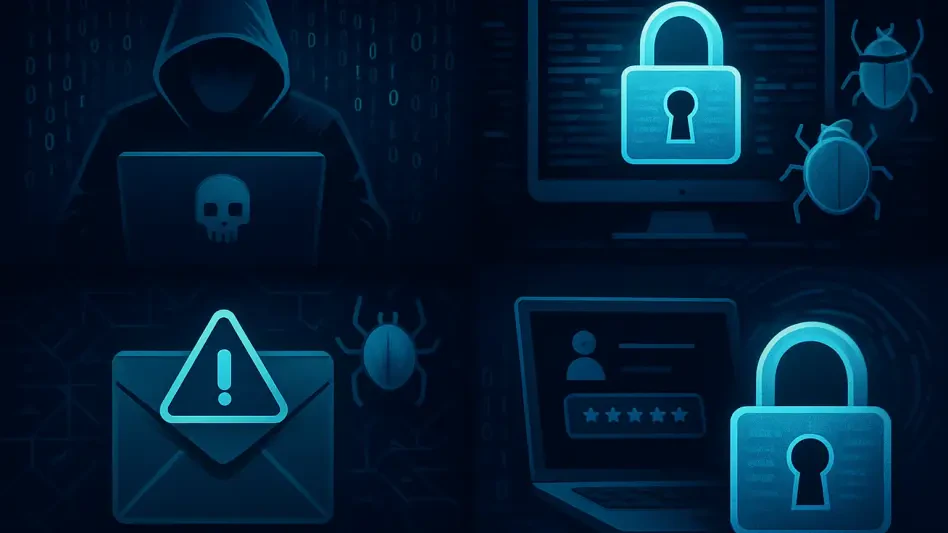In an era where digital threats loom larger than ever, the dark web stands as a stark reminder of the vulnerabilities that individuals and organizations face daily, serving as a hidden marketplace for stolen data like passwords, credit card details, and corporate secrets traded by cybercriminals with alarming ease. Far from being just a shadowy threat, the dark web offers invaluable insights for those willing to learn from its underbelly. As Cybersecurity Awareness Month unfolds, it’s the perfect time to explore how these dangers can translate into powerful strategies for safeguarding digital assets. This article delves into five critical takeaways derived from the dark web’s operations, focusing not on fear but on empowerment through knowledge. By understanding the mechanics of this hidden world, businesses and individuals alike can shift from reactive panic to proactive defense, staying ahead of those who exploit the unwary in the vast, interconnected landscape of the internet.
Peering into the Shadows: Risks of the Dark Web
The dark web operates as a concealed segment of the internet, accessible only through specialized tools, and it’s a thriving hub for illicit activities that pose significant risks to digital security. Hackers frequently use this space to sell compromised information, ranging from personal identities to sensitive business data, often at shockingly low prices. Understanding these threats is the first step toward effective protection. By tapping into dark web intelligence, it’s possible to detect leaked credentials or data breaches early, allowing for immediate actions like password changes or account lockdowns. This awareness transforms a potential disaster into a manageable issue, highlighting why familiarity with such risks is not optional but essential. In a digital economy where information equates to currency, ignoring this hidden marketplace can lead to catastrophic consequences, from identity theft to corporate espionage, making risk recognition a foundational pillar of cybersecurity.
Beyond just identifying risks, the dark web’s very existence underscores the urgency of staying informed about emerging threats as they evolve. Cybercriminals continuously adapt their methods, finding new ways to exploit vulnerabilities before they’re even widely known. For organizations, this means that static defenses are no longer sufficient; a dynamic approach to understanding what’s being traded or discussed in these shadowy forums becomes critical. Intelligence gathered from this space can reveal patterns, such as which industries are being targeted or what types of data fetch the highest prices, enabling tailored defensive strategies. For individuals, it serves as a wake-up call to monitor personal information that might surface in these illicit markets. The lesson here is clear: knowledge of the dark web’s risks isn’t just about reacting to breaches but about anticipating them, ensuring that protective measures are always one step ahead of malicious actors.
Staying Ahead with Dark Web Monitoring
One of the most actionable strategies inspired by dark web insights is the adoption of monitoring tools designed to track exposed data in real time. These solutions scan hidden marketplaces for signs of compromised information, such as email addresses or login credentials, providing alerts before cybercriminals can fully exploit them. This proactive stance significantly narrows the window of opportunity for attackers, often preventing minor leaks from escalating into full-blown crises. Businesses, regardless of size, benefit immensely from such technology, as it acts as an early warning system against threats that might otherwise go unnoticed for months. The emphasis here is on prevention over reaction, showcasing how modern tools can turn the tables on those operating in the shadows of the internet by keeping defenders informed and ready to act at a moment’s notice.
Moreover, dark web monitoring isn’t just a technical fix; it represents a shift in mindset toward continuous vigilance in an unpredictable digital landscape. For small and medium-sized enterprises, which often lack the resources of larger corporations, these tools democratize access to high-level security insights, leveling the playing field against sophisticated threats. The process often involves integrating alerts with existing security protocols, ensuring that any detected breach triggers a swift, coordinated response across teams. This approach also fosters accountability, as employees become more aware of the real-time risks their actions might pose, such as reusing passwords across platforms. Ultimately, monitoring serves as a bridge between the unseen dangers of the dark web and the tangible steps needed to protect sensitive information, reinforcing the importance of staying proactive rather than waiting for disaster to strike.
Building Strong Defenses with Simple Practices
Amid the complex threats emanating from the dark web, a surprising revelation emerges: many of these dangers can be mitigated through basic cybersecurity practices. Implementing strong, unique passwords for every account and enabling multi-factor authentication (MFA) creates formidable barriers against unauthorized access, even if credentials are stolen. These measures don’t require advanced technical expertise, yet their impact is profound, often stopping hackers in their tracks before they can cause significant harm. The dark web is littered with examples of breaches that could have been prevented by such straightforward habits, underscoring their value. This approach proves that effective defense doesn’t always demand complexity; sometimes, the simplest actions yield the strongest protection against even the most intricate schemes devised by cybercriminals.
Additionally, the power of these fundamental practices lies in their accessibility to everyone, from individual users to large organizations. Employee training programs can easily incorporate lessons on password hygiene and the importance of MFA, fostering a culture of security awareness at every level. Unlike costly or specialized solutions, these steps can be rolled out quickly and at minimal expense, making them ideal for entities with limited budgets. The dark web teaches that attackers often exploit the lowest-hanging fruit—weak passwords or single-factor logins—so addressing these vulnerabilities first can drastically reduce risk. This focus on simplicity also counters the intimidation factor of cyber threats, empowering users to take control of their digital safety without feeling overwhelmed by the perceived sophistication of dark web operations, thereby building confidence alongside security.
Data Protection as a Cornerstone of Trust
The implications of dark web activities extend far beyond technical breaches, directly impacting the trust and financial health of businesses. A single data leak, often traded in hidden forums, can shatter customer confidence, leading to reputational damage that’s hard to repair. Beyond that, the financial fallout from fines, lawsuits, or lost revenue can be staggering, especially for smaller firms with tight margins. Investing in robust data protection measures, such as encryption and regular security audits, becomes not just a technical necessity but a strategic imperative. These steps ensure that sensitive information remains secure, even if it falls into the wrong hands, preserving the integrity of business operations. The dark web serves as a harsh reminder that data isn’t just code—it’s the lifeblood of trust between companies and their stakeholders.
Furthermore, prioritizing data protection sends a powerful message to customers and partners about an organization’s commitment to security. Training staff to recognize phishing attempts or handle sensitive information properly adds another layer of defense, reducing the likelihood of human error leading to a breach. Encryption, meanwhile, renders stolen data useless to cybercriminals, neutralizing potential threats before they can be exploited on the dark web. This comprehensive approach ties cybersecurity to long-term business sustainability, showing that safeguarding information is as much about maintaining market position as it is about avoiding hacks. The lesson here is that data protection must be woven into the fabric of organizational strategy, ensuring resilience against the reputational and economic risks that lurk in hidden online marketplaces, and reinforcing the bond of trust with every safeguarded piece of information.
Fostering a Collaborative Cybersecurity Culture
The final lesson from the dark web emphasizes the need for a collective approach to cybersecurity, blending human awareness with cutting-edge technology. Encouraging collaboration across teams ensures that security isn’t just the responsibility of IT departments but a shared priority for everyone. Training initiatives can equip employees with the skills to identify and report suspicious activity, while advanced tools like machine learning-driven monitoring platforms enhance detection capabilities. This synergy between people and technology creates a robust defense system capable of adapting to new threats as they emerge. Small and medium-sized businesses, often prime targets for dark web actors due to perceived weaker defenses, stand to gain significantly from such integrated efforts, proving that strength lies in unity when facing digital dangers.
Equally important is the role of technology in scaling these collaborative efforts to meet the evolving landscape of cyber threats. Platforms that analyze dark web chatter for potential risks can be paired with internal communication channels to keep all staff informed and responsive. This integration fosters a proactive culture where updates on emerging threats are disseminated quickly, ensuring that defensive measures evolve in tandem with attacker tactics. Beyond internal collaboration, partnering with external cybersecurity experts can provide additional insights and resources, further fortifying an organization’s stance. The dark web reveals that isolated efforts are often insufficient against networked threats, making a collective, tech-supported strategy not just beneficial but necessary for long-term resilience in an increasingly interconnected digital world.
Charting the Path Forward in Digital Defense
Reflecting on the insights gleaned from the dark web, it’s evident that past efforts to combat cyber threats have often been reactive, addressing breaches only after significant damage was done. The lessons explored—ranging from risk awareness and proactive monitoring to simple defenses, data protection, and collaborative culture—provide a roadmap for a different approach. Moving forward, the focus should shift to integrating these strategies into everyday practices, ensuring that both individuals and organizations remain vigilant and prepared. Investing in accessible tools and fostering ongoing education become key steps to anticipate threats rather than merely respond to them. As the digital landscape continues to evolve, adopting scalable solutions and encouraging cross-team cooperation will be vital to staying ahead of cybercriminals. These actionable measures, inspired by past challenges, pave the way for a more secure future, turning the dark web’s lessons into lasting strengths.








